
Montmartre
Encyclopedia

Paris
Paris is the capital and largest city in France, situated on the river Seine, in northern France, at the heart of the Île-de-France region...
in the 18th arrondissement, a part of the Right Bank
Rive Droite
La Rive Droite is most associated with the river Seine in central Paris. Here the river flows roughly westwards, cutting the city into two: looking downstream, the northern bank is to the right, and the southern bank is to the left....
. Montmartre is primarily known for the white-domed Basilica of the Sacré Cœur
Basilica of the Sacré Cœur
The Basilica of the Sacred Heart of Paris, commonly known as Sacré-Cœur Basilica , is a Roman Catholic church and minor basilica, dedicated to the Sacred Heart of Jesus, in Paris, France. A popular landmark, the basilica is located at the summit of the butte Montmartre, the highest point in the city...
on its summit and as a nightclub district. The other, older, church on the hill is Saint Pierre de Montmartre
Saint Pierre de Montmartre
The Church of Saint Peter of Montmartre is the lesser known of the two main churches on Montmartre in Paris, the other being the 19th-century Sacré-Cœur Basilica...
, which claims to be the location at which the Jesuit order of priests was founded. Many artists had studios or worked around the community of Montmartre such as Salvador Dalí
Salvador Dalí
Salvador Domènec Felip Jacint Dalí i Domènech, Marquis de Púbol , commonly known as Salvador Dalí , was a prominent Spanish Catalan surrealist painter born in Figueres,Spain....
, Amedeo Modigliani
Amedeo Modigliani
Amedeo Clemente Modigliani was an Italian painter and sculptor who worked mainly in France. Primarily a figurative artist, he became known for paintings and sculptures in a modern style characterized by mask-like faces and elongation of form...
, Claude Monet
Claude Monet
Claude Monet was a founder of French impressionist painting, and the most consistent and prolific practitioner of the movement's philosophy of expressing one's perceptions before nature, especially as applied to plein-air landscape painting. . Retrieved 6 January 2007...
, Piet Mondrian
Piet Mondrian
Pieter Cornelis "Piet" Mondriaan, after 1906 Mondrian , was a Dutch painter.He was an important contributor to the De Stijl art movement and group, which was founded by Theo van Doesburg. He evolved a non-representational form which he termed Neo-Plasticism...
, Pablo Picasso
Pablo Picasso
Pablo Diego José Francisco de Paula Juan Nepomuceno María de los Remedios Cipriano de la Santísima Trinidad Ruiz y Picasso known as Pablo Ruiz Picasso was a Spanish expatriate painter, sculptor, printmaker, ceramicist, and stage designer, one of the greatest and most influential artists of the...
and Vincent van Gogh
Vincent van Gogh
Vincent Willem van Gogh , and used Brabant dialect in his writing; it is therefore likely that he himself pronounced his name with a Brabant accent: , with a voiced V and palatalized G and gh. In France, where much of his work was produced, it is...
. Montmartre is also the setting for several hit films. This site is served by metro
Paris Métro
The Paris Métro or Métropolitain is the rapid transit metro system in Paris, France. It has become a symbol of the city, noted for its density within the city limits and its uniform architecture influenced by Art Nouveau. The network's sixteen lines are mostly underground and run to 214 km ...
line 2
Paris Metro Line 2
Line 2 is one of the sixteen lines of the Paris Métro rapid transit system in Paris, France. Situated almost entirely above the former city walls , it runs in a semi-circle in the north of Paris....
stations of Anvers
Anvers (Paris Metro)
Anvers is a station on Paris Métro Line 2, on the border of the 9th and the 18th arrondissements in Montmartre.The station was opened on 21 October 1902 as part of the extension of line 2 from Étoile. It was the eastern terminus of the line until its extension to Bagnolet on 31 January 1903...
, Pigalle
Pigalle (Paris Metro)
Pigalle is a station on lines 2 and 12 of the Paris Métro, named after the Place Pigalle, which commemorates the sculptor Jean-Baptiste Pigalle on the border of the 9th and the 18th arrondissement...
and Blanche
Blanche (Paris Metro)
Blanche is a station on Paris Métro Line 2, on the border of the 9th and the 18th arrondissement. The station is located under the Boulevard de Clichy in Montmartre....
and the line 12
Paris Metro Line 12
Paris Métro Line 12 is one of sixteen metro lines in Paris, France. It links Issy-les-Moulineaux in southern Paris to Porte de la Chapelle in the north. With 72 million journeys per year, Line 12 is the eleventh busiest on the Parisian Métropolitan system...
stations of Pigalle, Abbesses
Abbesses (Paris Metro)
Abbesses is a station on Paris Métro Line 12, in the Montmartre district and the 18th arrondissement. Abbesses is one of the few deep stations of Paris métro, at 36 metres below ground, as it is located on western side of the butte of Montmartre...
, Lamarck - Caulaincourt and Jules Joffrin
Jules Joffrin (Paris Metro)
Jules Joffrin is a station on Line 12 of the Paris Métro in the Clignancourt district and the 18th arrondissement. It is located in Montmartre, between the town hall of the 18th arrondissement and the Notre-Dame-de-Clignancourt church....
.
Name origin
The toponym Mons Martis ("Mount of Mars" in Latin) survived into MerovingianMerovingian dynasty
The Merovingians were a Salian Frankish dynasty that came to rule the Franks in a region largely corresponding to ancient Gaul from the middle of the 5th century. Their politics involved frequent civil warfare among branches of the family...
times, Christianised as Montmartre, signifying 'mountain of the martyr'; it owes this name to the martyrdom of Saint Denis
Denis
Saint Denis is a Christian martyr and saint. In the third century, he was Bishop of Paris. He was martyred in connection with the Decian persecution of Christians, shortly after A.D. 250...
, who was decapitated on the hill around 250 AD. Saint Denis was the Bishop of Paris and is the patron saint
Patron saint
A patron saint is a saint who is regarded as the intercessor and advocate in heaven of a nation, place, craft, activity, class, clan, family, or person...
of France
France
The French Republic , The French Republic , The French Republic , (commonly known as France , is a unitary semi-presidential republic in Western Europe with several overseas territories and islands located on other continents and in the Indian, Pacific, and Atlantic oceans. Metropolitan France...
.
Prehistory
The hill's religious symbolism is thought to extend into prehistorical times, as it has been suggested as a likely druidDruid
A druid was a member of the priestly class in Britain, Ireland, and Gaul, and possibly other parts of Celtic western Europe, during the Iron Age....
ic holy place because it is the highest point in the area. No archeological evidence supports the claim.
16th century
During 1590 Siege of ParisSiege of Paris (1590)
The Siege of Paris took place in 1590 during the French Wars of Religion when the French Royal Army under Henry of Navarre, and supported by the French Huguenots, failed to capture the city of Paris defended by the Catholic League, and finally successfully relieved by the Spanish-Catholic army...
, part of the French Wars of Religion
French Wars of Religion
The French Wars of Religion is the name given to a period of civil infighting and military operations, primarily fought between French Catholics and Protestants . The conflict involved the factional disputes between the aristocratic houses of France, such as the House of Bourbon and House of Guise...
, the hills at Montmartre were used by Henry IV
Henry IV of France
Henry IV , Henri-Quatre, was King of France from 1589 to 1610 and King of Navarre from 1572 to 1610. He was the first monarch of the Bourbon branch of the Capetian dynasty in France....
to place his artillery
Artillery
Originally applied to any group of infantry primarily armed with projectile weapons, artillery has over time become limited in meaning to refer only to those engines of war that operate by projection of munitions far beyond the range of effect of personal weapons...
where they could fire down into the city. The siege eventually failed when a large relief force approached and forced Henry to withdraw.
18th century
In the 18th and 19th centuries, there were a number of gypsum mines in Montmartre. See Mines of ParisMines of Paris
The Mines of Paris comprise a number of abandoned, subterranean mines under Paris, France, connected together by galleries...
. A fossil
Fossil
Fossils are the preserved remains or traces of animals , plants, and other organisms from the remote past...
tooth found in one of these was identified by Georges Cuvier
Georges Cuvier
Georges Chrétien Léopold Dagobert Cuvier or Jean Léopold Nicolas Frédéric Cuvier , known as Georges Cuvier, was a French naturalist and zoologist...
as an extinct equine, which he dubbed Palaeotherium, the "ancient animal". His sketch of the entire animal in 1825 was matched by a skeleton discovered later.
19th century
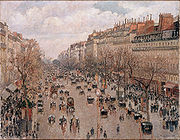
Battle of Paris (1814)
The Battle of Paris was fought during the Napoleonic Wars in 1814. The French defeat led directly to the abdication of Napoleon I.-Background:...
. They used the altitude of the hill for artillery bombardment of the city.
There is a memorial sign on one of the restaurants on Montmartre that says: On 30 March 1814 - here the Cossacks first launched their famous "Bistro" and thus on this summit occurred the worthy Ancestor of our Bistro
Bistro
A bistro, sometimes spelled bistrot, is, in its original Parisian incarnation, a small restaurant serving moderately priced simple meals in a modest setting. Bistros are defined mostly by the foods they serve. Home cooking with robust earthy dishes, and slow-cooked foods like cassoulet are typical...
s.
LE 30 MARS 1814
LES COSAQUES LANCÈRENT ICI
EN PREMIER, LEUR TRES FAMEUX "BISTRO"
ET, SUR LA BUTTE, NAQUIT AINSI
LE DIGNE ANCÊTRE DE NOS BISTROTS.
180eme ANNIVERSAIRE
SYNDICAT D'INTIATIVE DU VIEUX MONTMARTRE
Since Montmartre was outside the city limits, free of Paris taxes and no doubt also due to the fact that the local nuns made wine, the hill quickly became a popular drinking area. The area developed into a centre of free-wheeling and decadent entertainment at the end of the 19th and the beginning of the 20th centuries. In the popular cabaret the Moulin Rouge
Moulin Rouge
Moulin Rouge is a cabaret built in 1889 by Joseph Oller, who also owned the Paris Olympia. Close to Montmartre in the Paris district of Pigalle on Boulevard de Clichy in the 18th arrondissement, it is marked by the red windmill on its roof. The closest métro station is Blanche.The Moulin Rouge is...
, and at Le Chat Noir
Le Chat Noir
Le Chat Noir was a 19th-century cabaret, meaning entertainment house, in the bohemian Montmartre district of Paris...
, artists, singers and performers regularly appeared including Yvette Guilbert
Yvette Guilbert
Yvette Guilbert was a French cabaret singer and actress of the Belle Époque.-Biography:...
, Marcelle Lender
Marcelle Lender
Marcelle Lender was a French singer, dancer and entertainer made famous in paintings by Henri de Toulouse-Lautrec.Born Anne-Marie Marcelle Bastien, she began dancing at the age of sixteen and within a few years made a name for herself performing at the Théâtre des Variétés in Montmartre.Marcelle...
, Aristide Bruant
Aristide Bruant
Aristide Bruant was a French cabaret singer, comedian, and nightclub owner. He is best known as the man in the red scarf and black cape featured on certain famous posters by Henri de Toulouse-Lautrec...
, La Goulue
La Goulue
Louise Weber was a French can-can dancer who performed under the stage name of La Goulue...
, Georges Guibourg
Georges Guibourg
Georges Guibourg was a French singer, author, writer, playwright, and actor, George Guibourg, alias Georgius, alias Theodore Crapulet, was one of the most popular and versatile performers in Paris for more than 50 years....
, Mistinguett
Mistinguett
Mistinguett was a French actress and singer, whose birth name was Jeanne Bourgeois. She was at one time the best-paid female entertainer in the world...
, Fréhel
Fréhel
Fréhel was a French singer and actress.-Biography:Born in Paris, France to a poor and dysfunctional Breton family, Marguerite Boulc'h was a child left to a life on the streets in the dark side of Paris...
, Jane Avril
Jane Avril
Jane Avril was a French can-can dancer made famous by Henri de Toulouse-Lautrec through his paintings. Extremely thin, 'given to jerky movements and sudden contortions', she was nicknamed La Mélinite, after an explosive. -Biography:...
, Damia
Marie-Louise Damien
Marie-Louise Damien was a French singer and actress better known by the stage name Damia.-Robert Hollard:...
and others.
When Napoleon III and his city planner Baron Haussmann
Baron Haussmann
Georges-Eugène Haussmann, commonly known as Baron Haussmann , was a French civic planner whose name is associated with the rebuilding of Paris...
planned to make Paris the most beautiful city in Europe
Europe
Europe is, by convention, one of the world's seven continents. Comprising the westernmost peninsula of Eurasia, Europe is generally 'divided' from Asia to its east by the watershed divides of the Ural and Caucasus Mountains, the Ural River, the Caspian and Black Seas, and the waterways connecting...
, a first step was to grant large sweeps of land near the centre of the city to Haussmann's friends and financial supporters. This drove the original inhabitants to the edges of the city — to the districts of Clichy
Clichy, Hauts-de-Seine
-Administration:The canton covers a part of the commune; the other is in the northern part of Levallois-Perret-Twinnings: Heidenheim, Germany, since 1959 Sankt Pölten, Austria, since 1968 Santo Tirso, Portugal, since 1991 Rubí, Spain, since 2005 Southwark, United Kingdom, since 2005Clichy has also...
, La Villette, and the hill with a view of the city, Montmartre.
The Basilica of the Sacré Cœur
Basilica of the Sacré Cœur
The Basilica of the Sacred Heart of Paris, commonly known as Sacré-Cœur Basilica , is a Roman Catholic church and minor basilica, dedicated to the Sacred Heart of Jesus, in Paris, France. A popular landmark, the basilica is located at the summit of the butte Montmartre, the highest point in the city...
was built on Montmartre from 1876 to 1912 by public subscription as a gesture of expiation of the "crimes of the communards", after the Paris Commune
Paris Commune
The Paris Commune was a government that briefly ruled Paris from March 18 to May 28, 1871. It existed before the split between anarchists and Marxists had taken place, and it is hailed by both groups as the first assumption of power by the working class during the Industrial Revolution...
events, and to honour the French victims of the 1871 Franco-Prussian War
Franco-Prussian War
The Franco-Prussian War or Franco-German War, often referred to in France as the 1870 War was a conflict between the Second French Empire and the Kingdom of Prussia. Prussia was aided by the North German Confederation, of which it was a member, and the South German states of Baden, Württemberg and...
. Its white dome is a highly visible landmark in the city, and just below it artists still set up their easels each day amidst the tables and colourful umbrellas of Place du Tertre
Place du Tertre
The Place du Tertre is a square in Paris' XVIIIe arrondissement. Only a few streets away from Montmartre's Basilica of the Sacré Cœur and the Lapin Agile, it is the heart of the city's elevated Montmartre quarter....
.
At the beginning of his political career, the future French statesman Georges Clemenceau
Georges Clemenceau
Georges Benjamin Clemenceau was a French statesman, physician and journalist. He served as the Prime Minister of France from 1906 to 1909, and again from 1917 to 1920. For nearly the final year of World War I he led France, and was one of the major voices behind the Treaty of Versailles at the...
(1841–1929) was mayor of Montmartre.
Artists gather
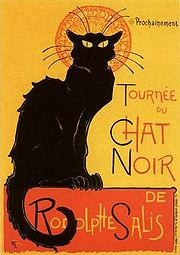
Johan Jongkind
Johan Barthold Jongkind was a Dutch painter and printmaker regarded as a forerunner of Impressionism who influenced Claude Monet....
and Camille Pissarro
Camille Pissarro
Camille Pissarro was a French Impressionist and Neo-Impressionist painter born on the island of St Thomas . His importance resides in his contributions to both Impressionism and Post-Impressionism, as he was the only artist to exhibit in both forms...
came to inhabit Montmartre. But only at the end of the century did the district become the principal artistic center of Paris. A restaurant opened near the old windmill near the top, the Moulin de la Galette
Moulin de la Galette
The Moulin de la Galette is a windmill and associated businesses situated near the top of the district of Montmartre in Paris. Since the 17th century the windmill has been known for more than just its milling capabilities...
.
Artists' associations such as Les Nabis
Les Nabis
Les Nabis were a group of Post-Impressionist avant-garde artists who set the pace for fine arts and graphic arts in France in the 1890s. Initially a group of friends interested in contemporary art and literature, most of them studied at the private art school of Rodolphe Julian in Paris in the...
and the Incoherents
Incoherents
The Incoherents was a short-lived French art movement founded by Parisian writer and publisher Jules Lévy in 1882, which in its satirical irreverence anticipated many of the art techniques and attitudes later associated with avant-garde and anti-art.Lévy coined the phrase "les arts incohérents" as...
were formed and individuals including Vincent van Gogh
Vincent van Gogh
Vincent Willem van Gogh , and used Brabant dialect in his writing; it is therefore likely that he himself pronounced his name with a Brabant accent: , with a voiced V and palatalized G and gh. In France, where much of his work was produced, it is...
, Pierre Brissaud
Pierre Brissaud
Pierre Brissaud was a French Art Deco illustrator, painter, and engraver whose father was Docteur Edouard Brissaud. He was born in Paris and trained at the École des Beaux-Arts and Atelier Fernand Cormon in Montmartre, Paris. His fellow Cormon students were his brother Jacques, André-Édouard...
, Alfred Jarry
Alfred Jarry
Alfred Jarry was a French writer born in Laval, Mayenne, France, not far from the border of Brittany; he was of Breton descent on his mother's side....
, Gen Paul
Gen Paul
Gen Paul , was a French painter and engraver.-Biography:Born as Eugène Paul in a house in Montmartre on the Rue Lepic painted by Van Gogh, he began drawing and painting as a child. His father died when he was only ten years old and Gen Paul was trained to work in decorative furnishings...
, Jacques Villon
Jacques Villon
Jacques Villon was a French cubist painter and printmaker.-Early life:Born Gaston Emile Duchamp in Damville, Eure, in the Haute-Normandie region of France, he came from a prosperous and artistically inclined family...
, Raymond Duchamp-Villon
Raymond Duchamp-Villon
Raymond Duchamp-Villon was a French sculptor.Duchamp-Villon was born Pierre-Maurice-Raymond Duchamp in Damville, Eure, in the Haute-Normandie region of France, the second son of Eugene and Lucie Duchamp. Of the six Duchamp children, four would become successful artists...
, Henri Matisse
Henri Matisse
Henri Matisse was a French artist, known for his use of colour and his fluid and original draughtsmanship. He was a draughtsman, printmaker, and sculptor, but is known primarily as a painter...
, André Derain
André Derain
André Derain was a French artist, painter, sculptor and co-founder of Fauvism with Henri Matisse.-Early years:...
, Suzanne Valadon
Suzanne Valadon
Suzanne Valadon was a French painter born Marie-Clémentine Valadon at Bessines-sur-Gartempe, Haute-Vienne, France. In 1894, Valadon became the first woman painter admitted to the Société Nationale des Beaux-Arts...
, Pierre-Auguste Renoir
Pierre-Auguste Renoir
Pierre-Auguste Renoir was a French artist who was a leading painter in the development of the Impressionist style. As a celebrator of beauty, and especially feminine sensuality, it has been said that "Renoir is the final representative of a tradition which runs directly from Rubens to...
, Edgar Degas
Edgar Degas
Edgar Degas[p] , born Hilaire-Germain-Edgar De Gas, was a French artist famous for his work in painting, sculpture, printmaking and drawing. He is regarded as one of the founders of Impressionism although he rejected the term, and preferred to be called a realist...
, Maurice Utrillo
Maurice Utrillo
Maurice Utrillo, , born Maurice Valadon, was a French painter who specialized in cityscapes. Born in the Montmartre quarter of Paris, France, Utrillo is one of the few famous painters of Montmartre who were born there....
, Henri de Toulouse-Lautrec
Henri de Toulouse-Lautrec
Henri Marie Raymond de Toulouse-Lautrec-Monfa or simply Henri de Toulouse-Lautrec was a French painter, printmaker, draughtsman, and illustrator, whose immersion in the colourful and theatrical life of fin de siècle Paris yielded an œuvre of exciting, elegant and provocative images of the modern...
, Théophile Steinlen
Théophile Steinlen
Théophile Alexandre Steinlen, frequently referred to as just Steinlen , was a Swiss-born French Art Nouveau painter and printmaker....
, and African-American expatriates such as Langston Hughes
Langston Hughes
James Mercer Langston Hughes was an American poet, social activist, novelist, playwright, and columnist. He was one of the earliest innovators of the then-new literary art form jazz poetry. Hughes is best known for his work during the Harlem Renaissance...
worked in Montmartre and drew some of their inspiration from the area.
Pablo Picasso
Pablo Picasso
Pablo Diego José Francisco de Paula Juan Nepomuceno María de los Remedios Cipriano de la Santísima Trinidad Ruiz y Picasso known as Pablo Ruiz Picasso was a Spanish expatriate painter, sculptor, printmaker, ceramicist, and stage designer, one of the greatest and most influential artists of the...
, Amedeo Modigliani
Amedeo Modigliani
Amedeo Clemente Modigliani was an Italian painter and sculptor who worked mainly in France. Primarily a figurative artist, he became known for paintings and sculptures in a modern style characterized by mask-like faces and elongation of form...
, and other impoverished artists lived and worked in a commune
Commune (intentional community)
A commune is an intentional community of people living together, sharing common interests, property, possessions, resources, and, in some communes, work and income. In addition to the communal economy, consensus decision-making, non-hierarchical structures and ecological living have become...
, a building called Le Bateau-Lavoir
Le Bateau-Lavoir
Le Bateau-Lavoir is a name which French painter Max Jacob coined for an area at the top of the steps leading to No. 13 Rue Ravigan, in Montmartre, Paris . The area is famous in art history because around the start of the 20th century a group of outstanding artists lived and rented artistic studios...
, during the years 1904–1909. Composers, including Satie (who was a pianist at Le Chat Noir
Le Chat Noir
Le Chat Noir was a 19th-century cabaret, meaning entertainment house, in the bohemian Montmartre district of Paris...
), also lived in the area.
The last of the bohemian
Bohemianism
Bohemianism is the practice of an unconventional lifestyle, often in the company of like-minded people, with few permanent ties, involving musical, artistic or literary pursuits...
Montmartre artists was Gen Paul
Gen Paul
Gen Paul , was a French painter and engraver.-Biography:Born as Eugène Paul in a house in Montmartre on the Rue Lepic painted by Van Gogh, he began drawing and painting as a child. His father died when he was only ten years old and Gen Paul was trained to work in decorative furnishings...
(1895–1975), born in Montmartre and a friend of Utrillo. Paul's calligraphic expressionist lithographs, sometimes memorializing picturesque Montmartre itself, owe a lot to Raoul Dufy
Raoul Dufy
Raoul Dufy[p] was a French Fauvist painter. He developed a colorful, decorative style that became fashionable for designs of ceramics and textiles, as well as decorative schemes for public buildings. He is noted for scenes of open-air social events...
.
Contemporary Montmartre
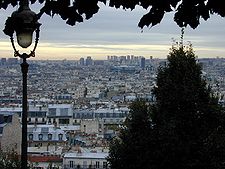
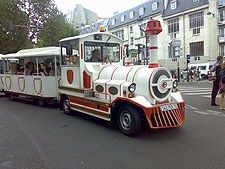
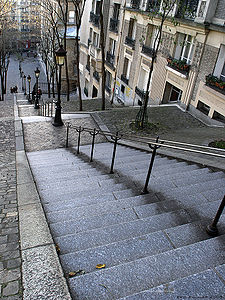
La Bohème (Charles Aznavour song)
La Bohème is a song written by Jacques Plante and Armenian-French artist Charles Aznavour. The original version of this song was written by Gipo Farassino a Piemont singer who wrote the song "Porta Pila." It was first recorded by Aznavour in 1966. It is Aznavour's signature song, as well as one of...
(1965), perhaps the best-known song by popular singer-songwriter Charles Aznavour
Charles Aznavour
Charles Aznavour, OC is an Armenian-French singer, songwriter, actor, public activist and diplomat. Besides being one of France's most popular and enduring singers, he is also one of the best-known singers in the world...
, a painter recalls his youthful years in a Montmartre that has ceased to exist: Je ne reconnais plus/Ni les murs, ni les rues/Qui ont vu ma jeunesse/En haut d'un escalier/Je cherche l'atelier/Dont plus rien ne subsiste/Dans son nouveau décor/Montmartre semble triste/Et les lilas sont morts ('I no longer recognize/Neither the walls nor the streets/That had seen my youth/At the top of a staircase/I look for a studio-apartment/Of which nothing survives/In its new décor/Montmartre seems sad/And the lilacs died'). The song is a farewell to what, according to Aznavour, were the last days of Montmartre as a site of bohemian activity.
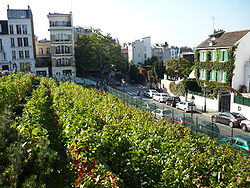
Vineyard
A vineyard is a plantation of grape-bearing vines, grown mainly for winemaking, but also raisins, table grapes and non-alcoholic grape juice...
in the Rue Saint-Vincent, which continues the tradition of wine production in the Île de France; it yields about 500 litres per year.
The Musée de Montmartre is in the house where the painter Maurice Utrillo
Maurice Utrillo
Maurice Utrillo, , born Maurice Valadon, was a French painter who specialized in cityscapes. Born in the Montmartre quarter of Paris, France, Utrillo is one of the few famous painters of Montmartre who were born there....
lived and worked in a second-floor studio. The mansion in the garden at the back is the oldest hotel on Montmartre, and one of its first owners was Claude Roze, also known as Roze de Rosimond, who bought it in 1680. Roze was the actor who replaced Molière
Molière
Jean-Baptiste Poquelin, known by his stage name Molière, was a French playwright and actor who is considered to be one of the greatest masters of comedy in Western literature...
, and, like his predecessor, died on stage. The house was Pierre-Auguste Renoir
Pierre-Auguste Renoir
Pierre-Auguste Renoir was a French artist who was a leading painter in the development of the Impressionist style. As a celebrator of beauty, and especially feminine sensuality, it has been said that "Renoir is the final representative of a tradition which runs directly from Rubens to...
's first Montmartre address and many other names moved through the premises.
Just off the top of the butte, Espace Dalí showcases surrealist
Surrealism
Surrealism is a cultural movement that began in the early 1920s, and is best known for the visual artworks and writings of the group members....
artist Salvador Dalí
Salvador Dalí
Salvador Domènec Felip Jacint Dalí i Domènech, Marquis de Púbol , commonly known as Salvador Dalí , was a prominent Spanish Catalan surrealist painter born in Figueres,Spain....
's work. Nearby, day and night, tourists visit such sights as the artists in Place du Tertre
Place du Tertre
The Place du Tertre is a square in Paris' XVIIIe arrondissement. Only a few streets away from Montmartre's Basilica of the Sacré Cœur and the Lapin Agile, it is the heart of the city's elevated Montmartre quarter....
and the cabaret du Lapin Agile
Lapin Agile
Lapin Agile is a famous Montmartre cabaret, at 22 Rue des Saules, 18th arrondissement of Paris, France.It was originally called "Cabaret des Assassins". Tradition relates that the cabaret received this name because a band of assassins broke in and killed the owner's son...
. Many renowned artists are buried in the Cimetière de Montmartre and the Cimetière Saint-Vincent.
Montmartre was the setting of the film La Môme, (La vie en rose) which elaborates on the life of famous French singer Edith Piaf
Édith Piaf
Édith Piaf , born Édith Giovanna Gassion, was a French singer and cultural icon who became widely regarded as France's greatest popular singer. Her singing reflected her life, with her specialty being ballads...
and her times in the slums of Paris, and of Amélie
Amélie
Amélie is a 2001 romantic comedy film directed by Jean-Pierre Jeunet. Written by Jeunet with Guillaume Laurant, the film is a whimsical depiction of contemporary Parisian life, set in Montmartre...
, the story of a young Parisian woman determined to help the lives of others and find her true love, is set in an exaggeratedly quaint version of contemporary Montmartre. 2001's Moulin Rouge!
Moulin Rouge!
Moulin Rouge! is a 2001 romantic jukebox musical film directed, produced, and co-written by Baz Luhrmann. Following the Red Curtain Cinema principles, the film is based on the Orphean myth, La Traviata, and La Bohème...
was also set in Montmartre, the story of a young man who believes in truth, beauty, freedom, and love, and who falls in love with a famous courtesan. 1954's Moulin Rouge
Moulin Rouge (1952 film)
Moulin Rouge is a 1952 film directed by John Huston, produced by Sir John Woolf and James Woolf of Romulus Films and released by United Artists. The film is set in Paris in the late 19th century, following artist Henri de Toulouse-Lautrec in the city's bohemian sub-culture in and around the...
, solely about the life and lost loves of painter Henri de Toulouse-Lautrec
Henri de Toulouse-Lautrec
Henri Marie Raymond de Toulouse-Lautrec-Monfa or simply Henri de Toulouse-Lautrec was a French painter, printmaker, draughtsman, and illustrator, whose immersion in the colourful and theatrical life of fin de siècle Paris yielded an œuvre of exciting, elegant and provocative images of the modern...
, also took place in the district.
Montmartre is an officially designated historic district with limited development allowed in order to maintain its historic character.
A funicular
Funicular
A funicular, also known as an inclined plane or cliff railway, is a cable railway in which a cable attached to a pair of tram-like vehicles on rails moves them up and down a steep slope; the ascending and descending vehicles counterbalance each other.-Operation:The basic principle of funicular...
railway, the Funiculaire de Montmartre, operated by RATP, ascends the hill from the south while the Montmartre Bus circles the hill.
Downhill to the southwest is the red-light district
Red-light district
A red-light district is a part of an urban area where there is a concentration of prostitution and sex-oriented businesses, such as sex shops, strip clubs, adult theaters, etc...
of Pigalle. That area is, today, largely known for a wide variety of stores specializing in instruments for rock music. There are also several concert halls, also used for rock music. The actual Moulin Rouge theatre is also in Pigalle, next to Blanche métro station.
See also
- the Fête des vendanges of Montmartre, which assembles more than 350,000 people during the first October weekend, every year,
- the Place du TertrePlace du TertreThe Place du Tertre is a square in Paris' XVIIIe arrondissement. Only a few streets away from Montmartre's Basilica of the Sacré Cœur and the Lapin Agile, it is the heart of the city's elevated Montmartre quarter....
, where various painters are painting tourists for pleasure (and also money), - the Espace Dali, museum dedicated to several masterpieces of the surrealist artist,
- the DalidaDalidaDalida , born with Italian name of Iolanda Cristina Gigliotti, was a world-famous singer and actress born in Egypt with Italian origins but naturalised French with the name Yolanda Gigliotti. She spent her early years in Egypt amongst the Italian Egyptian community, but she lived most of her adult...
house in rue d'Orchampt, - the place Dalida,
- the place PigallePlace PigalleThe Place Pigalle is a public square located in the 9th arrondissement of Paris, between the Boulevard de Clichy and the Boulevard de Rochechouart, near Sacré-Cœur, at the foot of the Montmartre hill...
and the Moulin RougeMoulin RougeMoulin Rouge is a cabaret built in 1889 by Joseph Oller, who also owned the Paris Olympia. Close to Montmartre in the Paris district of Pigalle on Boulevard de Clichy in the 18th arrondissement, it is marked by the red windmill on its roof. The closest métro station is Blanche.The Moulin Rouge is...
in the south, - the marché Saint-Pierre, area of the cloth sellers in the south-east,
- the working class districts taking in a lot of immigrated people: BarbèsBarbèsBarbès is the debut album by French–Algerian singer Rachid Taha. It was released by Barclay Records in 1991.-Track listing:All songs written and composed by Rachid Taha.# "Confiance" – 5:40# "Barbès" – 4:25# "Gazelle" – 4:41# "Lela" – 4:24...
(MaghrebMaghrebThe Maghreb is the region of Northwest Africa, west of Egypt. It includes five countries: Morocco, Algeria, Tunisia, Libya, and Mauritania and the disputed territory of Western Sahara...
) in the south east, Château Rouge (black AfricaBlack AfricaBlack Africa is a Namibian football team from Katutura, Windhoek that plays in the Namibia Premier League.-Achievements:*Namibia Premier League: 6*NFA-Cup: 3-Performance in CAF competitions:...
) in the east, - the boulevard de RochechouartBoulevard de RochechouartThe Boulevard de Rochechouart is situated at the foot of Montmartre and to its south. Like the neighbouring street it is named after Marguerite de Rochechouart de Montpipeau , abbess of Montmartre. It is a result of the 1864 merging of the boulevards and chemins de ronde which followed the...
(metro stations : Anvers and Pigalle) for its concert halls (La CigaleLa CigaleLa Cigale is a theater at 120, boulevard de Rochechouart near Place Pigalle, in the 18th arrondissement of Paris. The theatre is part of a complex that is connected to Le Trabendo and the Boule Noire. The hall can accommodate 1389 people or 954 people...
, L'Elysée-Montmartre, Le Trianon, La Boule Noire) inspired from the 19th century cabarets, - the cimetière de Montmartre,
- the famous and often sung rue LepicRue LepicRue Lepic is an ancient road in the commune of Montmartre, in the 18th arrondissement of Paris, climbing the hill of Montmartre from the boulevard de Clichy to the place Jean-Baptiste-Clément...
with its Les Deux Moulins café, made famous around the world by Le Fabuleux Destin d'Amélie Poulain movie, - the Erik SatieErik SatieÉric Alfred Leslie Satie was a French composer and pianist. Satie was a colourful figure in the early 20th century Parisian avant-garde...
's house, - the Musée de Montmartre,
- rue Saint-Vincent, the vigne de Montmartre, the most famous of the parisian vineyards (there are some others, in particular in the parc Georges Brassens in the 15ème arrondissement of Paris). Its wine is quite expensive ; the earnings are used to help social institutions. It is overhung by beautiful buildings from the 20s,
- Le Chat noirLe Chat NoirLe Chat Noir was a 19th-century cabaret, meaning entertainment house, in the bohemian Montmartre district of Paris...
and the Lapin AgileLapin AgileLapin Agile is a famous Montmartre cabaret, at 22 Rue des Saules, 18th arrondissement of Paris, France.It was originally called "Cabaret des Assassins". Tradition relates that the cabaret received this name because a band of assassins broke in and killed the owner's son...
cabarets whose clientele was mainly French artists in the beginning of the 20th century, - the Moulin de la GaletteMoulin de la GaletteThe Moulin de la Galette is a windmill and associated businesses situated near the top of the district of Montmartre in Paris. Since the 17th century the windmill has been known for more than just its milling capabilities...
, - the funiculaire de Montmartre, a people lift, one can use instead of the stairs to ascend the butte Montmartre
- the place Émile-Goudeau, where the Bateau-Lavoir welcomes great painters,
- Place Jean-MaraisPlace Jean-MaraisThe Place Jean-Marais is a square in Paris' 18th arrondissement of Paris, in the front of the Saint-Pierre de Montmartre, not afar from Place du Tertre, on the top of Montmartre.It was named for the famous actor Jean Marais on 26 April 2008...

